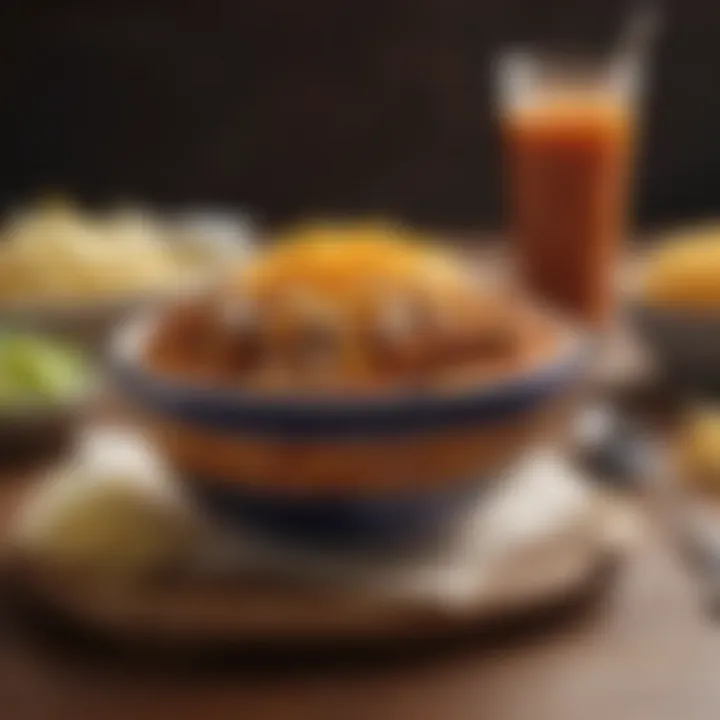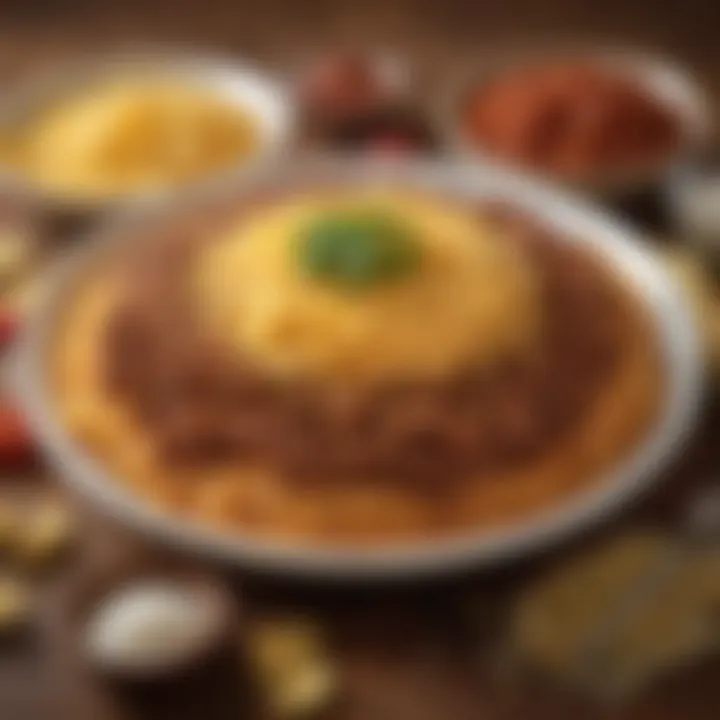Skyline Chili: Exploring Its Recipe and Legacy


Intro
Skyline Chili represents more than just a meal; it is a cultural phenomenon deeply rooted in Cincinnati, Ohio. Known for its unique blend of spices and distinct presentation, Skyline Chili has carved a niche in American cuisine that continues to endure. The chili is notable for its secret recipe, which features a harmony of flavors that diverges significantly from traditional chili con carne.
The preparation and ingredients used offer a thorough exploration of both comfort food and culinary ingenuity. By examining its legacy, this article aims to enlighten readers about why Skyline Chili holds a distinctive place not just in local palates but also in the wider realm of American food culture.
Preface to Skyline Chili
Skyline Chili is more than just a meal; it is a cultural institution for many in America, particularly in the Midwest. Understanding its significance requires diving into its unique recipe and the history behind it. In this section, we will explore how Skyline Chili came to be, its impact on local communities, and why it remains an admired dish today.
Historical Context
Skyline Chili originated in the early 1940s in Cincinnati, Ohio. The dish was created by Greek immigrant Tom Kiradjieff, who aimed to introduce the flavors of his homeland to American cuisine. The first Skyline Chili restaurant opened in 1949, and it quickly began to attract a loyal clientele. Over time, the dish evolved, taking on characteristics unique to the Cincinnati area. Culinary history often highlights how immigrant communities adapt their traditions to their new environments, and Skyline Chili is an embodiment of this. The blend of spices, meat, and sauce serves as a testament to the way food can reflect cultural assimilation while preserving heritage.
Cultural Significance
Skyline Chili holds a special place in the hearts of its fans. Its unique flavor profile—often described as a sweeter take on traditional chili—has inspired various serving styles, such as the popular three-way, which includes spaghetti, chili, and cheese. This dish does not just satisfy hunger; it sparks conversations and creates a sense of community among its devourers.
Moreover, the brand has expanded beyond Cincinnati, capturing audiences in new markets. Although it is often met with mixed reactions from newcomers unfamiliar with its peculiar taste and presentation, Skyline Chili continuously represents comfort and nostalgia to those who grew up enjoying it. The restaurant’s presence at local sporting events and charity functions further cements its role in fostering communal identity.
"Skyline Chili is not just a food; it's a symbol of our city's spirit and resilience."
In summary, Skyline Chili is deeply intertwined with the history and culture of Cincinnati, making it a dish deserving of exploration and understanding. Recognizing its roots and communal significance allows for a richer appreciation of the dish and its place in American culinary tradition.
Key Ingredients
The significance of key ingredients in Skyline Chili cannot be overstated. They contribute to the flavor, texture, and overall authenticity of the dish. Understanding these components is vital for anyone looking to replicate this iconic recipe. The combination of meat, spices, and accoutrements creates a harmonious balance that defines Skyline Chili.
Main Ingredients Overview
At the core of Skyline Chili lies a few essential ingredients. The main component is typically a ground beef base, which provides the necessary protein and a hearty texture. Another foundational ingredient is tomato sauce, adding depth and a hint of sweetness to the dish. Onions also play a crucial role, offering a sharpness that balances the flavors.
Additionally, Skyline Chili often features kidney beans as part of the meal, particularly in the Cincinnati-style three-way or four-way preparations. Cheese, specifically shredded cheddar, is commonly used as a topping, enhancing the dish with creamy richness. Each ingredient influences the flavor profile and is carefully selected to ensure that the Skyline experience remains authentic.
The Role of Spices
Spices are what truly distinguish Skyline Chili from other chili recipes. The blend of spices is what enhances the flavor, providing a unique taste that is specific to this dish. Common spices include cinnamon, allspice, and chili powder. These ingredients may seem unconventional for a chili, yet they are crucial for achieving the characteristic taste.
The use of cocoa powder is another notable choice; it lends a slight bitterness that complements the sweetness of the tomatoes. This unconventional mixture of spices creates layers of flavor that are complex and deeply satisfying. Understanding how these spices work together is essential for recreating the Skyline experience at home.
Meat Selection


Choosing the right kind of meat is another vital part of the Skyline Chili recipe. While ground beef is the most common choice, variations exist based on personal preference and dietary needs. Some might opt for ground turkey for a leaner option, while others may choose tofu in vegetarian adaptations. The important aspect here is the texture; the meat must be finely ground so that it blends seamlessly with the sauce and spices.
Furthermore, quality matters. Fresh, high-quality meat leads to a more flavorful result. With the right meat selection, the dish not only becomes more enjoyable to eat but also preserves the traditional essence of Skyline Chili. Each choice affects the final outcome, making meat selection a significant consideration in the overall preparation.
Recipe Breakdown
The process of crafting Skyline Chili is both an art and a science. Understanding the Recipe Breakdown is vital for anyone looking to recreate this iconic dish at home. This section addresses specific elements involved in the preparation and cooking of Skyline Chili, allowing readers to appreciate the nuances that contribute to its unique flavor profile. Analyzing each step offers insight not only into the method but also into how each component interacts to produce the final dish.
Preparation Method
The preparation of Skyline Chili begins with a meticulous approach to ingredient selection. The first step involves gathering high-quality ground beef, onions, tomato sauce, and a variety of spices. Each ingredient plays a crucial role in defining the chili's character. Typically, onions are sautéed until transparent, which helps to build a deep flavor base. Combining the beef with the cooked onions adds a rich texture that enhances the dish’s overall mouthfeel.
Once combined, the next step requires the addition of tomato sauce and the unique blend of spices that includes chili powder, cumin, and allspice. This mixture should be simmered gently to allow the spices to meld, with each flavor adding to the complexity.
Cooking Process
The cooking process for Skyline Chili is where the dish truly starts to embody its distinct identity. After the ingredients are combined, the mixture should be simmered on low heat. This slow cooking allows flavors to deepen and encourages the formation of a harmonious blend. Traditional Skyline Chili may simmer for several hours, stirring occasionally to ensure that nothing settles at the bottom.
It is essential to monitor the consistency throughout this period; it should not be too thick nor too watery. Adjusting the liquid content at this stage is critical.
Cooking time can vary, but the goal is to achieve a rich sauce that clings well to the noodles and toppings. Each home cook may need to adjust based on their stove and pot size, adding an element of personal touch to the recipe.
Timing and Temperature
Timing and temperature are key factors in the success of Skyline Chili. The mixture should ideally be cooked for about 1 to 2 hours, maintained at a low simmer. If the temperature is too high, it may cause the meat to become tough and the sauce to burn, compromising the final flavor. Conversely, cooking at too low of a temperature may not allow the spices to properly release their flavors.
The perfect balance of time and temperature creates a rich, thick chili that embodies the essence of Skyline.
Monitoring the odor and appearance of the chili can also serve as indicators of readiness. A well-cooked Skyline Chili should present a vibrant hue and a fragrant aroma, which suggests that the flavorful elements have melded successfully.
Serving Suggestions
When it comes to enjoying Skyline Chili, serving suggestions play a pivotal role in enhancing the overall experience of this iconic dish. The way Skyline Chili is presented can accentuate its flavors and even reflect its cultural heritage. Whether served in a traditional manner or in more creative ways, the options are plentiful. This section will explore classic pairings and innovative variations, providing insights into how to best enjoy this unique chili.
Classic Pairings
Skyline Chili is best known for its distinct flavor, which pairs well with a variety of accompaniments. Traditional pairings include:
- Spaghetti: A generous serving of Skyline Chili over a bed of spaghetti is the most common presentation. The noodles provide a texture that complements the chili's thickness.
- Cheddar Cheese: Shredded cheese often crowns the chili, adding richness that balances its flavors. A thick layer of cheese allows for a satisfying melt, creating a creamy experience.
- Onions: Diced onions add a fresh crunch that cuts through the richness of the chili. Some prefer them raw, while others like them sautéed for a softer flavor.
- Hot Sauce: For those who enjoy a kick, a drizzle of hot sauce can amplify the flavors and offer a new depth of heat.
- Beans and Rice: Although traditional Skyline Chili generally does not include beans, serving it alongside seasoned beans or rice can complement the dish without overshadowing its unique taste.
Serving these components together creates a culinary harmony that maintains the integrity of Skyline Chili while also providing a balanced meal.


Creative Variations
While the traditional serving method of Skyline Chili is beloved, there are numerous creative variations that can enhance this dish:
- Chili Cheese Fries: Replace the spaghetti with crispy fries and pour Skyline Chili over them. Add cheese and jalapeños for an indulgent twist.
- Skyline Chili Nachos: Spread tortilla chips on a plate, layer with chili, cheese, and toppings such as jalapeños and sour cream for a uniquely American appitizer.
- Chili Dogs: Serve Skyline Chili over hot dogs, topped with cheese and onions. This option is quick and embraces the flavors perfectly.
- Chili Stuffed Peppers: Hollow out bell peppers and fill them with Skyline Chili, cheese, and other toppings before baking them in the oven.
- Chili Soup: For a lighter approach, turn Skyline Chili into a soup by diluting it with additional broth. This can make it a more versatile dish for a warm day.
The versatility of Skyline Chili allows for these innovative servings to stand alongside the traditional recipes, ensuring that it can be enjoyed in various contexts.
"Skyline Chili is not just a meal; it’s a cultural experience that can be adapted and enjoyed in many creative forms."
Each suggestion presented caters to different palates and occasions, showcasing just how flexible this dish can be.
Nutritional Information
Understanding the nutritional information of Skyline Chili is essential for informed dietary choices. This dish, rich in protein and flavor, brings delight to those who savor it. However, it's important to balance enjoyment with health considerations. While Skyline Chili is a cherished part of American cuisine, it also requires an understanding of its nutritional profile, especially for those with specific dietary goals or restrictions.
Caloric Breakdown
Skyline Chili's caloric content can vary significantly depending on portion size and ingredients. A typical serving contains approximately 300-400 calories, largely influenced by the meat, beans, and added toppings. Here’s a simple breakdown:
- Chili base: 200-250 calories, primarily from meat and beans.
- Toppings: Cheese, onions, and other additions can add around 50-100 calories each.
- Serving style: Over spaghetti or as a coney can increase calorie count substantially.
To enjoy Skyline Chili while being mindful of calories, consider adjusting serving sizes or customizing toppings. Reducing cheese or opting for smaller portions can significantly influence the total caloric intake without sacrificing taste.
Dietary Considerations
Several dietary considerations apply to those contemplating Skyline Chili.
- High in protein: Beneficial for muscle repair and growth, aiding those with active lifestyles.
- Fat content: Skyline Chili can be high in saturated fats, particularly when prepared with certain meat cuts.
- Sodium levels: With a flavor profile enriched by spices, it also tends to contain higher sodium levels, which may be a concern for hypertensive individuals.
- Allergies: Ingredients such as wheat in buns or gluten in certain variations may pose challenges to individuals with allergies or intolerances.
For vegetarians and vegans, adaptations are possible. In these cases, using plant-based protein sources can lower calorie counts while still offering a hearty meal option. Understanding these considerations ensures that enjoyment of Skyline Chili fits well into personal health goals.
Variations of Skyline Chili
Skyline Chili has established itself as a beloved dish within American cuisine, yet its adaptability allows for a range of variations that cater to diverse palates and dietary preferences. Understanding these variations expands the appeal and usability of this iconic recipe. This section explores the regional differences that contribute to distinct takes on Skyline Chili, as well as the growing vegetarian versions that reflect changing dietary trends.
Regional Differences
Skyline Chili's fame is primarily rooted in Cincinnati, Ohio. However, as its reputation spread, regional adaptations started emerging across the United States. Each area brought a unique twist to the classic recipe, creating a rich tapestry of flavors and techniques.
For instance, in some regions, additional toppings such as jalapeños or hot sauce have been introduced, reflecting the local taste for heat. In contrast, other areas may emphasize a more robust meat flavor or alter the spice blend. The variations often depend on local ingredients, cooking methods, and even cultural influences.


- Cincinnati Style: The original Skyline Chili is typically served over spaghetti, topped with shredded cheese, onions, and beans. This combination has become a benchmark for authenticity.
- Michigan Style: In Michigan, a distinct interpretation includes a traditional hot dog smothered in chili, often referred to as "Michigan Chili." This variation emphasizes a different format for enjoying the same beloved flavors.
- West Coast Influences: Adaptations on the West Coast may include fresher ingredients or unique toppings like avocado, aligning the dish with regional culinary trends.
Each of these regional differences not only showcases the popularity of Skyline Chili but also highlights the ways in which this dish can be personalized based on location.
Vegetarian Versions
As dietary preferences evolve, vegetarian and vegan adaptations of Skyline Chili have gained traction. The traditional meat-based recipe can pose challenges for those who prefer plant-based diets. However, several creative strategies exist to maintain the spirit of Skyline Chili while removing meat components.
The foundation often remains the same, centered around the spice blend and the chili sauce. Key substitutions include:
- Lentils: A common alternative to ground meat, lentils provide a hearty texture and soak up the flavors of the chili sauce well.
- Vegetable Protein: Products like Beyond Meat or tempeh offer a meat-like consistency while being entirely plant-based.
- Beans: Black beans, kidney beans, or chickpeas can add both nutrition and flavor, enhancing the chili while keeping it vegetarian-friendly.
Many recipes adapt the original Skyline Chili formula without losing sight of what makes the dish so appealing. Whether accepting or rejecting the meat component, the options reflect a growing inclination towards inclusivity in culinary traditions, ensuring that fans of Skyline Chili can enjoy it regardless of dietary restrictions.
In summary, Variations of Skyline Chili reflect the dish’s ability to evolve while maintaining its core essence. Understanding these adaptations not only enhances appreciation for Skyline Chili but also encourages experimentation in the kitchen.
Skyline Chili in Popular Culture
Skyline Chili has carved out a unique position within the tapestry of American culture. Its influence extends far beyond just being a beloved dish; it has woven itself into the very fabric of regional identity, community gatherings, and culinary discussions. The popularity of Skyline Chili reflects not only its flavor profile but also the connections it fosters among people. This section explores key aspects of how Skyline Chili manifests in various cultural outlets and the community's involvement with it.
Media References
Skyline Chili has been referenced across multiple media platforms, from local television shows to national culinary competitions. It often appears in documentaries that highlight culinary traditions in the United States, showcasing its role in Cincinnati's food culture. Examples include segments on food travel shows that explore regional dishes or features on cooking shows that challenge chefs to replicate its recipe.
Another notable reference is in local commercials which not only emphasize the taste but also the nostalgia associated with family traditions and hometown pride. Additionally, social media platforms such as Instagram and TikTok often see a surge of posts showcasing the dish, with hashtags that highlight its distinctiveness and encourage others to try it. These digital engagements play a crucial role in keeping the legacy of Skyline Chili alive among younger generations, revealing its status as more than just a meal, but a cultural phenomenon.
Community Engagement
Community interaction with Skyline Chili is robust and multifaceted. Many neighborhoods hold chili cook-offs and food festivals that celebrate not just Skyline but also other local variations. These events create a space for enthusiasts to gather, share tips, and explore the culinary landscape of Cincinnati and beyond. The local skyline restaurants often participate in events that promote local food culture, enhancing their community ties.
Moreover, Skyline Chili's charitable initiatives show a commitment to social responsibility. The brand has been involved in various philanthropic activities, supporting local schools and organizations. This alignment with community values further solidifies its position as an essential part of local culture and heritage.
Engagement with Skyline Chili is not merely about consumption; it reflects a sense of identity and belonging. The shared experiences over a bowl of Skyline foster connections that transcend simple dining, making it an integral part of many people's lives.
"In every bowl of Skyline Chili, there’s a story waiting to be shared."
As we can see, Skyline Chili's impact is significant in media and community arenas, making it an ongoing topic of interest in discussions about American cuisine and cultural identity.
The End
The conclusion of this guide encapsulates the essence of Skyline Chili and its significance within the larger culinary landscape. It serves as a valuable recap for readers, ensuring that they have grasped the key themes discussed throughout the article. Understanding Skyline Chili extends beyond just recognizing a unique dish; it intertwines with cultural narratives and regional pride.
Summarizing Key Points
- Historical Context: Skyline Chili originated in the early 20th century in Cincinnati, evolving into a beloved icon.
- Ingredients and Preparation: The distinct taste of Skyline Chili comes from a combination of carefully selected ingredients and a unique blend of spices, creating a rich flavor profile.
- Culinary Variations: The dish inspires a broad range of adaptations, catering to different dietary preferences and regional tastes.
- Cultural Impact: Skyline Chili holds a special place in American culture, featured in various media and local community events.
- Serving Suggestions: The article explores various ways to serve Skyline Chili, emphasizing traditional pairings as well as innovative variations.
Final Thoughts on Skyline Chili
Skyline Chili is more than just a meal; it is an enduring symbol of Cincinnati and an integral part of American culinary history. Its unique flavor and versatility invite both nostalgia and exploration for food lovers. As home cooks attempt to recreate this iconic dish, they become part of its legacy, ensuring that Skyline Chili will continue to be celebrated across generations. In summary, this iconic chili represents a convergence of history, culture, and culinary creativity, making it worthy of attention and admiration.







